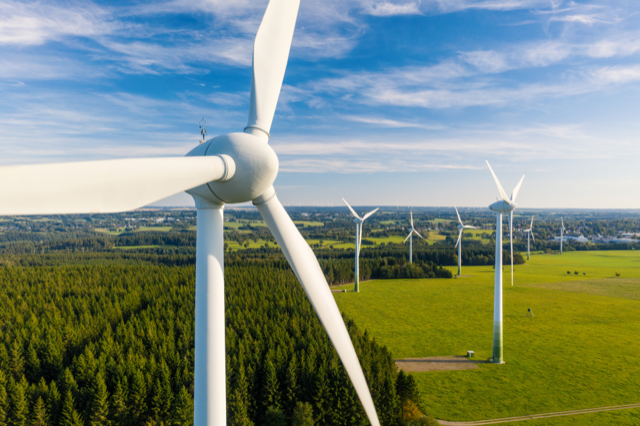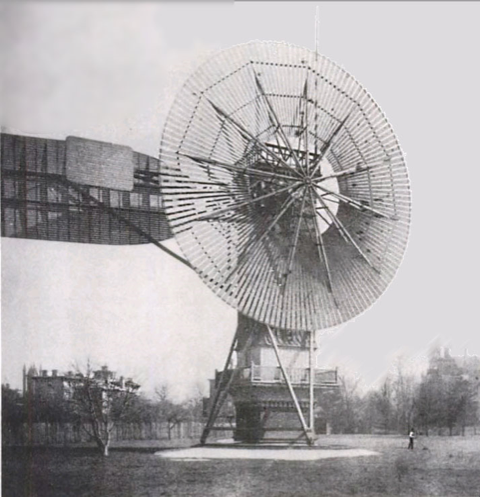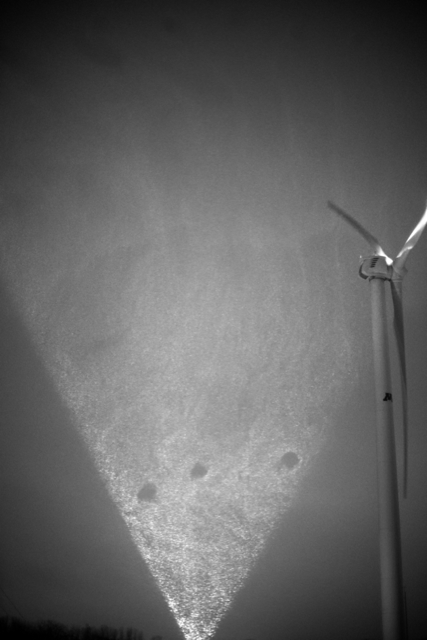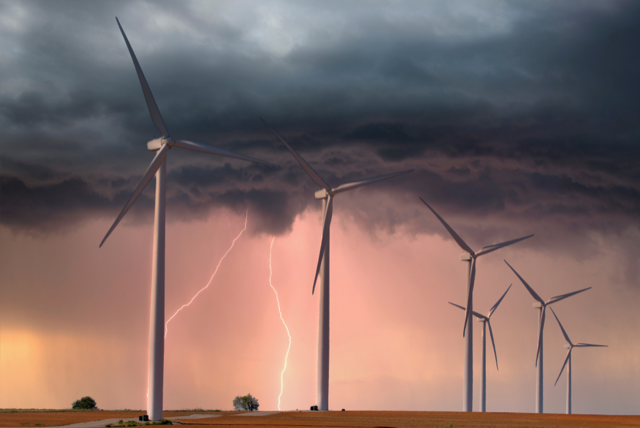The Answer is Blowing in the Turbine
This article is part of a series of pieces on environmental topics that Physics is publishing to celebrate Earth Day (April 22). See also: Research News: Breaking Barriers to Polymer Recycling; Arts & Culture: Serenading a Troubled Ocean; Opinion: Renewable Energy’s Intermittency is Not a Showstopper; Q&A: The Lure of Cement.
Julie Lundquist never planned to study thunderstorms, but a video posted on social media called out for her expertise. In June of 2019, the atmospheric scientist from the University of Colorado, Boulder, clicked on an animation of a wind farm in Lubbock, Texas, that showed the farm’s turbines collectively deflecting the path of a gust of wind from an oncoming thunderstorm. Comments from other viewers indicated their incredulity at the possibility of such a feat, but, Lundquist says, she had no doubts that the apparent trick could happen. “I knew that the phenomenon could occur and that I could prove it.”
Lundquist and her then graduate student, Jessica Tomaszewski, published a paper last year on how turbines can bend a storm’s trajectory. They showed that the turbines interact with the atmosphere in the same way that the trees of a forest or the buildings of a city do, imposing a drag on weather disturbances that is large enough to alter their paths. While Lundquist calls the study “fun,” she notes that it has serious implications: Understanding if and how wind farms alter weather features is a top concern for farmers, who depend on rain. (In this case, Lundquist and Tomaszewski found that the turbine interaction produced no detectable change in the amount of precipitation the storm dumped on the wind farm’s surroundings.)
The storm-bending study solved one conundrum about how wind turbines interact with the atmosphere, but many issues remain open. Among them are key questions related to how air circulation—both naturally occurring and turbine-induced—impacts the potential power generation capabilities of a wind farm. Answering those questions is crucial to maximally exploiting this technology, which, if adopted in sufficient abundance, has the potential to provide all of the world’s electricity and then some, according to a 2019 report from the International Energy Agency.
Lundquist says that solving many of the open wind-turbine problems will require new modeling and simulation tools that can accurately replicate wind flows over a range of length- and timescales that current techniques have difficulty capturing. To do that, researchers are currently focused on increasing the resolution of simulations to probe the weather effects that influence wind-farm output. Verifying these models will require more experimental data, says Matthew Lackner, who studies problems related to offshore wind farms at the University of Massachusetts, Amherst. Current and upcoming projects are studying wind farms in new ways, such as using snowflakes to track wind patterns, and implementing large-scale wind-turbine experiments. “If we can get high-resolution data and couple it to models, then we could really understand what’s going on,” Lackner says.
The Height Problem
Modeling how wind turbines interact with the atmosphere was, for a long time, relatively easy, Lundquist says. That’s because the first turbines, which extended just a few tens of meters into the sky, operated in the so-called surface layer of the atmosphere, a region whose behavior scientists know how to predict.
The surface layer of the atmosphere, as its name implies, is the layer closest to Earth. In this layer, the wind motion is highly turbulent, swirling around in a constantly changing pattern. But, Lundquist says, despite the topsy-turvy motion, this part of the atmosphere is “a little bit boring,” as scientists can make many simplifying assumptions about the wind’s behavior. For example, models of surface-layer-dwelling turbines assume that the wind speed increases logarithmically with height and that the blades encounter a constant level of turbulence—the wind is swirling, but the swirls always look roughly the same. “You can basically assume that the part of the atmosphere that a [short] turbine interacts with is homogeneous,” Lundquist says. “The approximations all work very well,” she adds, and they allow theorists to accurately predict the power output of a small-turbine wind farm.
However, today’s turbines are 12 times taller than the first ones, reaching up to 300 m above the ground. That lofty height means that modern turbines extend beyond the surface layer, operating instead in the so-called atmospheric boundary layer, where many of the short-turbine assumptions fail. In the atmospheric boundary layer, the wind’s properties—speed, direction, and turbulence—are much more complex and fast-changing. And while researchers have made experimental measurements of the boundary layer, traditional models struggle to capture the layer’s behaviors, making them poor predictors of wind farm outputs.
“The variability in the wind behavior in the boundary layer of the atmosphere has been unappreciated for many years,” says Sue Ellen Haupt, the deputy director of the Research Applications Laboratory at the National Center for Atmospheric Research, Colorado. “We need to understand the impact of that variability to manage renewable energy resources.”
Jets, Wakes, and Power Changes
One poorly captured boundary-layer wind feature is the nocturnal jet, which is essentially a tube of fast-moving wind that appears at night at a height of between 150 and 500 m—the same height as the center of a turbine’s rotor. The jets are caused by a rapid cooling of Earth’s surface after sunset, and the wind within them typically changes direction across their height. That means that the blades must grapple with wind coming from two different directions, which makes it harder for a turbine’s blades to smoothly rotate, Lundquist says.
While jets often have a positive impact on wind-farm output, Lundquist and her colleagues have shown that, in some cases, the wind veer caused by nocturnal jets can temporarily reduce the power output of a wind farm by 10%, a factor large enough to make a dent in a farm’s profitability during those periods. The crisscrossing wind also puts a higher load on a turbine’s blades, which other researchers have shown can damage a turbine and cause it to fail sooner than predicted. Lundquist notes that farmers in Iowa—a place known for its nocturnal jets—have informally told her that turbines on their land have needed blade replacements every two to three years rather than the 15 years that the farmers had expected. Those more frequent repairs reduce the positive environmental impact of a wind farm, since more blades go to a landfill.
Another factor that impacts wind farm output is the wake produced by a turbine. The wake is a region of low-speed wind that begins just behind a turbine’s rotor. The speed reduction extends for a few tens to a few hundreds of meters, a distance large enough that the wake of one turbine can change the wind conditions for a downwind turbine. “One of the major causes of power loss in a wind farm is poorly placed wind turbines,” says fluid-dynamics expert Jiarong Hong of the University of Minnesota. Experiments and simulations show that “downstream turbines that sit in the wake of an upstream turbine can have strongly reduced power-generation capabilities,” he says, with the reduction being in the range of 10–30%. But the models do not provide a full picture of the wake dynamics. Hong and his Ph.D. student Aliza Abraham are trying to remedy that.
To understand the impact of wakes, Hong and Abraham have developed a method to image wakes that uses snow to capture the swirls of the wind inside these features. In their experiments—which were all conducted on freezing, dark, wind-swept nights—Hong, Abraham, and their colleagues filmed snowfall illuminated with stage lights, sheltering in cars to stay warm between takes. They then used software to track and analyze the motion of the snowflakes in their video recordings.
Using this technique, the team has captured the dynamics of 3D flows around a single wind turbine located in Rosemont, Minnesota, finding some previously unseen behaviors. For example, the team observed interactions between coherent flow structures, which appear as snowflake-less voids in the turbine’s wake. These interactions have largely been ignored in both previous field experiments and idealized experiments using scaled-down turbines in wind tunnels. “In the lab, the structure of wakes varies little over time, but our experiments show that [this behavior] is not what happens for industry-sized turbines,” Hong says. The time-varying flows impact how much a wake interacts with downwind turbines, potentially reducing their power output.
The Scale Challenge
The experiments of Hong and Abraham provide an important view into the wind-flow patterns around a single turbine. But to really understand flow patterns at wind farms, researchers need multiturbine measurements, which are currently limited, says Patrick Moriarty, an aeronautical engineer at the National Renewable Energy Laboratory (NREL), Colorado. He hopes to fill in that data gap with measurements from the American Wake Experiment (AWAKEN), a campaign that Moriarty leads. This experiment, which should start taking data this year, will use lasers, radar, and aircraft to study wind dynamics at five large commercial wind farms in northern Oklahoma. “We are trying to capture data across as many of the scales as possible,” Moriarty says.
Obtaining data across different scales is crucial for creating accurate models for wind-farm outputs, says Paul Veers, a wind-energy scientist at NREL. The performance of a single turbine depends on everything from 100-km-wide global weather patterns to millimeter-wide eddies on the surface of a blade. “No one model or one experiment can currently resolve all the time and spatial scales of the problem,” Veers says. This “scale” challenge was one of the main wind-energy hurdles that Veers, Lundquist, Moriarty, and 26 others highlighted in a 2019 paper in Science.
In theory, researchers could solve this multiscale flow problem numerically on a supercomputer by sequentially resolving all the relevant scales with different models. But the scale range is so wide that it would take weeks to months on Fugaku (the world’s fastest supercomputer) to simulate the effects of a single set of wind conditions on one wind-farm configuration, says Takafumi Nishino, who studies wind-farm aerodynamics at the University of Oxford, UK. To optimize turbine configuration, wind-farm operators must simulate many thousands of possible scenarios, so he says that this approach would be impractical.
Researchers often get away with focusing on one scale and ignoring all others, but a better solution is to improve existing models by incorporating information on more length scales. Lundquist is taking this approach, adapting weather models so that they resolve wind-farm-relevant scales.
Most weather models divide Earth’s atmosphere up into a grid made of cells that are 1 km or more in width. That size is small enough to capture 100-km-wide weather features, such as hurricanes and cyclones. But the cubes are too big, Lundquist says, to properly resolve the wind-farm-relevant scales in the kilometer to meter range.
One fix, which Lundquist takes, is to reduce the grid size, particularly in the vertical direction, so that she can better simulate smaller wind features and better distinguish the varying wind behaviors in different levels of the atmosphere. “When you decrease the grid size of a model, you have a better chance of capturing what’s happening,” she says. That grid refinement has revealed how quirky wind patterns, such as “mountain waves,” can impact a wind farm. A different fix is to use artificial intelligence algorithms to calculate the correcting factors for weather prediction models, says Haupt. “The machine-learning algorithm can learn that there is some bias [in weather-model predictions] for a particular wind farm and correct for that,” she says.
A General Theory for Wind
While grid resizing and other workarounds can help in certain instances, they don’t solve the scale problem, says Nishino. “What we really need is a general theory of wind-farm aerodynamics that concisely describes core relationships between the flows of different scales,” a theory that he has been working to develop.
In a paper published in April 2020, Nishino presented a “two-scale momentum” theory, in which he derived the relationship between three key parameters that link the small-scale turbine flows with the large-scale atmospheric flows that impact wind-farm output. The idea, he says, is that researchers could then use this relationship to predict the long-term power-generation behavior of a wind farm. Nishino and colleagues recently explained how the theory could be verified using numerical weather models.
This theoretical treatment, says Nishino, could make wind-farm optimization quicker and also more accurate, as the derived relationship includes details of how the incoming wind speed impacts the speed reduction caused by the turbines. “Farm optimization generally doesn’t factor in how large-scale atmospheric conditions affect how much the wind speed is reduced by the turbines in the wind farm,” he says. “Use of my two-scale momentum theory could change that.”
–Katherine Wright
Katherine Wright is the Deputy Editor of Physics Magazine.








